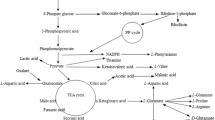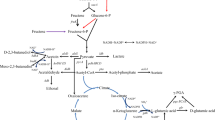Abstract
The components of the media used to elicit the biosynthesis of poly-γ-glutamic acid (γ-PGA) byBacillus subtilis ZJU-7 were investigated, particularly the carbon and nitrogen sources. Of the 7 carbon sources investigated, sucrose induced the highest rate of γ-PGA productivity; among the nitrogen sources, tryptone had the best effect for γ-PGA production. A 26−2 fractional factorial design was used to screen factors that influence γ-PGA production significantly, and a central composite design was finally adopted to formulate the optimal medium. γ-PGA productivity improved approximately 2-fold when the optimal medium was used compared with the original nonoptimized medium, and volumetric productivity reached a maximum of 58.2 g/L after a 24-h cultivation period.
Similar content being viewed by others
References
Sekine, T., T. Nakamura, Y. Shimizu, H. Ueda, K. Matsumoto, Y. Takimoto, and T. Kiyotani (2000) A new type of surgical adhesive made of porcine collagen and poly glutamic acid.J. Biomed. Mater. Res. 35: 305–310.
Li, C., J. E. Price, L. Milis, N. R. Hunter, S. Ke, D. F. Yu, C. Charnsangavej, and S. Wallace (1999) Antitumor activity of poly(l-glutamic acid)-paclitaxel on syngeneic and xenografted tumors.Clin. Cancer Res. 5: 891–897.
Kadowaki, M. and T. Noguchi (2001) Natto mucilage containing poly-γ-glutamic acid increase soluble calcium in the rat small intestine.Biosci. Biotechnol. Biochem. 65: 516–521
Choi, H. J. and M. Kunioka (1995) Preparation conditions and swelling equilibria of hydrogel prepared by γ-irradiation from microbial poly(γ-glutamic acid).Radiar. Phys. Chem. 46: 175–179.
McLean, R. J., D. Beauchemin, L. Clapham, and T. I. Beveridge (1990) Metal-binding characteristics of the gamma-glutamyl capsular polymer ofBacillus licheniformis ATCC 9945.Appl. Environ. Microbiol. 56: 3671–3677.
Ivánovics, G. and V. Bruckner (1937) Chemische und immunologische Studien über den Mechanismus der Milzbrandinfektion und Immunität; die chemische Struktur der Kapselsubstanz des Milzbrandbazillus und der serologisch identischen spezifischen Substanz desBacillus mesentericus. Z. Immunitätsforsch Exp Ther 90: 304–318.
Thorne, C. B. and C. G. Leonard (1958) Isolation of D-and L-glutamyl polypeptides from culture filtrates ofBacillus subtilis.J. Biol. Chem. 233: 1109–1112.
Ward, R. M., R. F. Anderson, and F. K. Dean (1963) Polyglutamic acid production byBacillus subtilis NRRL B-2612 grown on wheat gluten.Biotechnol. Bioeng. 5: 41–48.
Aumayr, A., T. Hara, and S. Ueda (1981) Transformation ofBacillus subtilis in polyglutamate production by coxyribonucleic acid fromB. natto.J. Gen. Appl. Microbiol. 27: 115–123.
Kambourova, M., M. Tangney, and F. G. Priest (2001) Regulation of polyglutamic acid synthesis by glutamate inBacillus licheniformis andBacillus subtilis.Appl. Environ. Microbiol. 67: 1004–1007.
Feng, S., X. Zhinan and C. Peilin, Efficient production of poly-γ-glutamic acid by a new strainBacillus Subtilis ZJU-7.Appl. Biochem. Biotechnol. In press.
Chen, H. C. (1996) Optimizing the concentrations of carbon, nitrogen, and phosphorus in a citric acid fermentation with response surface method.Food Biotechnol. 10: 13–27.
Rao, P. V., K. Jayaraman, and C. M. Lakshmanan (1993) Production of lipase byCandida rugosa in solid-state formentation. 2: Medium optimization and effect of aeration.Process Biochem. 28: 391–395.
Harris, P. L., S. L. Cuppett, and L. B. Bullerman (1990) Optimization of lipase synthesis byPseudomonas fluorescens by response surface methodology.J. Food. Protect 53: 481–483.
Bazaraa, W. A. and E. E. Hassan (1996) Response surface optimization for the continuous glucose isomerization process.J. Ind. Microbiol. Biotechnol. 17: 100–103.
Maddox, I. S. and S. H. Richert (1977) Use of response surface methodology for the rapid optimization of microbiological media.J. Appl. Bacteriol. 43: 197–204.
Goto, A. and M. Kunioka (1992) Biosynthesis and hydrolysis of poly(γ-glutamic acid) fromBacillus subtilis IFO3335.Biosci. Biotechnol. Biochem. 56: 1031–1035.
Hansen, B. M. and N. B. Hendriksen (2001) Detection of enterotoxicBacillus cereus andBacillus thuringiensis strains by PCR analysis.Appl. Environ. Microbiol. 67: 185–189.
Adinarayana, K., P. Ellaiah, B. Srinivasulu, R. Bhavani Devi, and G. Adinarayana (2003) Response surface methodological approach to optimize the nutritional parameters for neomycin production byStreptomyces marinensis under solid-state fermentation.Process Biochem. 38: 1565–1572.
Strobel, R. J. and G. R. Sullivan (1999) Experimental design for improvement of fermentation. pp. 80–93. In: A. L. Demain and J. E. Davies (eds.).Manual of Industrial Microbiology and Biotechnology. 2nd ed, ASM Press, Washington, DC, USA.
Kennedy, M. and D. Krouse (1999) Strategies for improving fermentation medium performance: a review.J. Ind. Microbiol. Biotechnol. 23: 456–475.
Ashiuchi, M., K. Tani, K. Soda, and H. Misono (1998) Properties of glutamate racemase fromBacillus subtilis IFO 3336 producing poly-γ-glutamate.J. Biochem. 123: 1156–1163.
Ogawa, Y., F. Yamaguchi, K. Yuasa, and Y. Tahara (1997) Efficient production of γ-poly glutamic acid byBacillus licheniformis (natto) in jar fermenters.Biosci. Biotechnol. Biochem. 61: 1684–1687.
Kubota, H. (1993) production of poly(γ-glutamic acid) byBacillus subtilis F 201.Biosci. Biotechnol. Biochem. 57: 1212–1213.
Author information
Authors and Affiliations
Corresponding author
Rights and permissions
About this article
Cite this article
Shi, F., Xu, Z. & Cen, P. Optimization of γ-polyglutamic acid production byBacillus subtilis ZJU-7 using a surface-response methodology. Biotechnol. Bioprocess Eng. 11, 251–257 (2006). https://doi.org/10.1007/BF02932039
Received:
Accepted:
Issue Date:
DOI: https://doi.org/10.1007/BF02932039




